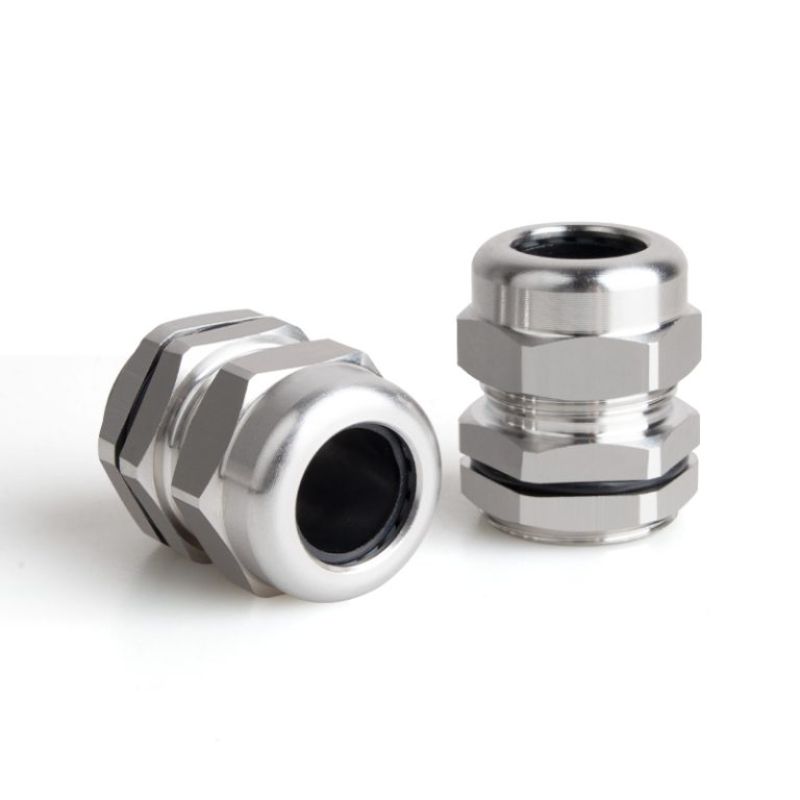What are Cable Glands?
Cable glands are connectors used to seal the ends of cables and secure them to plugs, terminals, enclosures or electrical equipment of various kinds. They can protect sensitive electrical wiring from moisture, contamination, corrosion and even flammable gas.
Glands are used for cables laid outdoors or in harsh environments, and also for passing cabling through plating or bulkheads. Cable glands are used with all types of power, data, control, instrumentation, automation and telecommunication cable.
They have a number of alternative names, including mechanical cable entry devices, cable connectors, cable fittings, and cord grips.

How Do Cable Glands Work?
Cable glands are made by combining a central enclosure or body through which cabling can pass with several attachments. These are typically a lock (or check) nut, washers, seal, attachment claw or cone, and a sealing (or compression) nut. Some models also feature two-part enclosures, tags for electrical earthing, PVC shrouding (insulation) or neoprene (rubber) sealing.
The size, arrangement and design of these vary according to the type of cable gland. Cable glands have the following principal functions:
Fixing cables in place and preventing them from being twisted or accidentally pulled out
Providing an airtight seal to keep out dust, dirt, water and moisture - a key function with electrical equipment
Fortifying the cable against strain
Protecting the vulnerable end of the cable from damage. Some also help to earth electrical cables and cut the risk of shocks and electrocution
Cable glands are made from a range of materials, including:
PVC (polyvinyl chloride) - a flexible and non-reactive plastic
PTFE (polytetrafluoroethylene) - this plastic is highly resistant to chemicals and similar substances
Nylon - a tough, multipurpose choice with strong resistance to pressure
Steel, aluminium and brass
Synthetic rubbers
Types of Cable Glands
There are four principal types of cable gland:
Single compression - typically used within buildings and for smaller installations
Double compression - mainly used in power plants and factories where stronger seals are required. These glands feature double sealing and the application of double compression at the cable core and on the outer sheathing or armour
Flexible hose - used in higher temperature locations
PVC - typically used for control cables attached to instrumentation
Both single and double-compression cable glands are further divided into three additional types:
Threading (the mechanical grooves applied to the nuts or attachments) also varies from gland to gland. Look for the following standards, each with different uses:
When choosing the correct cable gland, look for the following criteria:
The minimum and maximum operating temperature
The pressure rating - i.e. the maximum pressure the cable will tolerate before leaking or breaking
The size and type of cabling it is compatible with, something principally determined by the diameter of the gland. Most cable glands are available in a range of diameters to match
The size and type of mounting featured - i.e. the head which seals the cable into place. These are normally threaded
Armoured cable glands are designed for use with steel-wired armoured (SWA) cables, also known simply as armoured cable. This is the standard for underground and wall cabling installations. The steel mesh protects the cable from damage.
Waterproof Cable Glands
Waterproof cable glands typically offer IP68 waterproofing, meaning that they can resist immersion in water one metre or more in depth. The International Protection (IP) standard is a widely used marker of resistance to water, dust and other contaminants.
Metal cable glands made from stainless steel, aluminium, and brass offer a range of benefits:
Stainless steel is a good choice for corrosion and pressure resistance
Aluminium is flexible, resistant to rust and also conducts heat and electricity well
Brass is a time-honoured choice offering strength and resistance to magnetism and deformation at both high and low temperatures. It also offers good electrical conductivity. It is widely used in the construction industry and industrial settings
Six types of brass cable glands are available:
Indoor - a versatile design good for different types of cable, including armoured, plastic and rubber-sheathed
Outdoor - these can be used with both plastic or rubber sheathed and unsheathed cables
Straightening - these are used with both rubber sheathed and unsheathed cables and can be used in both indoor and outdoor settings
Weatherproof - these cable glands are used with both plastic or rubber sheathed cables and are built to be robust and provide a strong seal. A variation of this gland is specifically designed for maximum resistance to water
Threaded - these are custom-made glands used for certain industrial applications
Industrial - this gland is principally used with plastic or rubber sheathed and armoured cabling
Rubber Cable Glands
The watertight seals in some types of cable glands are made from synthetic rubber. Chloroprene is used to make o-rings, a circular gasket that forms an efficient seal. Neoprene, meanwhile, is more typically used for washers - i.e. flat sealant rings.
For more information please contact YDT




